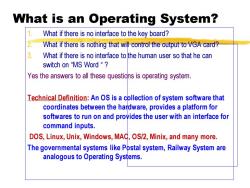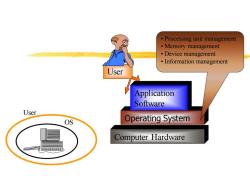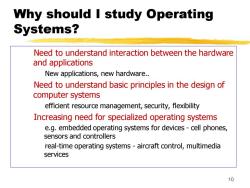同济大学:《大学计算机基础》课程教学资源(教案讲义)Operating system 1

Operating Systems 1
1 Operating Systems

Operating System Question: Who should take the responsibility if the bus does not come on time? Dispatcher's task:meet the requirement of buses and passengers Least waiting time for passengers Largest passenger capacity for buses
Operating System Question: Who should take the responsibility if the bus does not come on time? Dispatcher’s task:meet the requirement of buses and passengers ◼ Least waiting time for passengers ◼ Largest passenger capacity for buses

>Wenzhou train collision disaster >Shanghai metro line 10 3
3 ➢Wenzhou train collision disaster ➢Shanghai metro line 10

Basic Principles of Operating Systems An operating system is a collection of software that coordinates the working of the different components of the system and gets the user's job done.The operating system provides the user with all the basic things necessary to do his job. Is it enough to have microsoft word to write letters? No. Surprised?
Basic Principles of Operating Systems An operating system is a collection of software that coordinates the working of the different components of the system and gets the user’s job done. The operating system provides the user with all the basic things necessary to do his job. Is it enough to have microsoft word to write letters? No. Surprised?

What is an Operating System? 1.What if there is no interface to the key board? 2 What if there is nothing that will control the output to VGA card? 3. What if there is no interface to the human user so that he can switch on"MS Word“? Yes the answers to all these questidns is operating system. Technical Definition:An OS is a collection of system software that coordinates between the hardware,provides a platform for softwares to run on and provides the user with an interface for command inputs. DOS,Linux,Unix,Windows,MAC,OS/2,Minix,and many more. The governmental systems like Postal system,Railway System are analogous to Operating Systems
1. What if there is no interface to the key board? 2. What if there is nothing that will control the output to VGA card? 3. What if there is no interface to the human user so that he can switch on “MS Word “ ? Yes the answers to all these questions is operating system. Technical Definition: An OS is a collection of system software that coordinates between the hardware, provides a platform for softwares to run on and provides the user with an interface for command inputs. DOS, Linux, Unix, Windows, MAC, OS/2, Minix, and many more. The governmental systems like Postal system, Railway System are analogous to Operating Systems. What is an Operating System?

Processing unit management Memory management 。Device management Information management User Application Software User OS Operating System Computer Hardware 山
Computer Hardware Operating System Application Software User • Processing unit management • Memory management • Device management • Information management OS User

Goals of an Operating System Simplify the execution of user programs and make solving user problems easier. Use computer hardware efficiently. Allow sharing of hardware and software resources. Make application software portable and versatile. Provide isolation,security and protection among user programs. Improve overall system reliability error confinement,fault tolerance,reconfiguration
7 Goals of an Operating System Simplify the execution of user programs and make solving user problems easier. Use computer hardware efficiently. Allow sharing of hardware and software resources. Make application software portable and versatile. Provide isolation, security and protection among user programs. Improve overall system reliability error confinement, fault tolerance, reconfiguration

Operating System Services Program Development-variety of services and utilities such as Editors and debuggers.They are usually referred to as application program development tools. Program Execution-involves a number of steps,such as loading Instruction and data in the main memory,initialization of l/O devices and files and other resources to be allocated.OS handles the scheduling. .Access to l/O devices-Each I/O device has its own set of Instructions and control signals.O.S.hides these details to provide a common interface to the user/programmer
Operating System Services • Program Development – variety of services and utilities such as Editors and debuggers. They are usually referred to as application program development tools. • Program Execution – involves a number of steps, such as loading Instruction and data in the main memory, initialization of I/O devices and files, and other resources to be allocated. OS handles the scheduling. •Access to I/O devices – Each I/O device has its own set of Instructions and control signals. O.S. hides these details to provide a common interface to the user/programmer

Operating System Services .Controlled access to files-nature of /O device (disk drive,tape drive)and structure of the data stored in the files in the storage medium.In the case of multiple users accessing the processor concurrently,proper protection mechanisms have to be used. System access-For shared or public systems,the O.S.controls access to the system as a whole and to specific system resources.Access system provides protection of resources,and data from unauthorized users,and resolves resource conflicts Error detection and response-Variety of errors may occur in computer system.Responses may range from program termination,retrial of the same operation,or reporting error to the application. Accounting-collecting usage statistics,CPU usages,monitor performance,etc
Operating System Services • Controlled access to files- nature of I/O device (disk drive, tape drive) and structure of the data stored in the files in the storage medium. In the case of multiple users accessing the processor concurrently, proper protection mechanisms have to be used. • System access- For shared or public systems, the O.S. controls access to the system as a whole and to specific system resources. Access system provides protection of resources, and data from unauthorized users, and resolves resource conflicts • Error detection and response – Variety of errors may occur in computer system. Responses may range from program termination, retrial of the same operation, or reporting error to the application. • Accounting – collecting usage statistics, CPU usages, monitor performance, etc

Why should I study Operating Systems? Need to understand interaction between the hardware and applications New applications,new hardware.. Need to understand basic principles in the design of computer systems efficient resource management,security,flexibility Increasing need for specialized operating systems e.g.embedded operating systems for devices-cell phones, sensors and controllers real-time operating systems-aircraft control,multimedia services 10
10 Why should I study Operating Systems? Need to understand interaction between the hardware and applications New applications, new hardware.. Need to understand basic principles in the design of computer systems efficient resource management, security, flexibility Increasing need for specialized operating systems e.g. embedded operating systems for devices - cell phones, sensors and controllers real-time operating systems - aircraft control, multimedia services
按次数下载不扣除下载券;
注册用户24小时内重复下载只扣除一次;
顺序:VIP每日次数-->可用次数-->下载券;
- 同济大学:《大学计算机基础》课程教学资源(教案讲义)Fundamentals of Network 2.ppt
- 同济大学:《大学计算机基础》课程教学资源(教案讲义)Fundamentals of Network 1.ppt
- 同济大学:《大学计算机基础》课程教学资源(教案讲义)Basics of Multimedia 2.ppt
- 同济大学:《大学计算机基础》课程教学资源(教案讲义)Mail Merge.ppt
- 同济大学:《大学计算机基础》课程教学资源(教案讲义)Basics of Multimedia 1.ppt
- 同济大学:《大学计算机基础》课程教学资源(教案讲义)Fundamentals of Computers Introduction(负责人:臧笛).ppt
- 同济大学:《大学计算机基础》课程教学资源(教案讲义)Microsoft Excel.ppt
- 同济大学:《大学计算机基础》课程教学资源(教案讲义)Database.ppt
- 同济大学:《大学计算机基础》课程教学资源(教案讲义)Basics of Computer System.ppt
- 同济大学:《大学计算机基础》课程教学资源(教案讲义)Data Representation.ppt
- 同济大学:《大学计算机基础》课程教学资源(试卷习题)试卷样本及答案.doc
- The Not So Short Introduction to LaTeX2ε(Or LATEX 2ε in 139 minutes).pdf
- 上饶师范学院:《数据库系统原理》课程教学资源(PPT课件)数据库系统概论 An Introducation to Database System(完整版).ppt
- 上饶师范学院:《数据库系统原理》课程教学资源(电子教案)数据库系统原理电子教案(共九章).doc
- 上饶师范学院:《数据库系统原理》课程教学资源(资料讲义)数据库系统原理实验讲义(上机实验讲义).doc
- 上饶师范学院:《数据库系统原理》课程教学资源(试卷习题)数据库系统原理习题集及答案.doc
- 上饶师范学院:《数据库系统原理》课程教学资源(资料讲义)数据库系统原理总复习(负责人:颜清).doc
- 上饶师范学院:《数据库系统原理》课程教学资源(试卷习题)数据库系统原理模拟试卷(考试模拟试题,共十套,含参考答案).doc
- 西安电子科技大学:《计算机网络 Computer Networks》课程教学资源(PPT课件讲稿)第四章 网络层.pptx
- 西安电子科技大学:《计算机网络 Computer Networks》课程教学资源(PPT课件讲稿)第三章 数据链路层.pptx
- 同济大学:《大学计算机基础》课程教学资源(教案讲义)Operating system 2.ppt
- 南京大学:《计算理论之美》课程教学资源(课件讲稿)Cluster expansion lemma.pdf
- 南京大学:《计算理论之美》课程教学资源(课件讲稿)Color Coding.pdf
- 南京大学:《计算理论之美》课程教学资源(课件讲稿)Distributed Consensus Reaching Agreement in Faulty Environment.pdf
- 南京大学:《计算理论之美》课程教学资源(课件讲稿)Principles of Quantum Computation.pptx
- 南京大学:《计算理论之美》课程教学资源(课件讲稿)Some efficient algorithms for the k-vertex cover problem.pdf
- 南京大学:《计算理论之美》课程教学资源(课件讲稿)Lovász Local Lemma(LLL).pdf
- 南京大学:《计算理论之美》课程教学资源(课件讲稿)Perfect Sampling for(Atomic)Lovász Local Lemma.pptx
- 南京大学:《计算理论之美》课程教学资源(课件讲稿)An introduction to quantum error-correction.pdf
- 南京大学:《计算理论之美》课程教学资源(课件讲稿)Lovász local lemma(Shearer).pdf
- 南京大学:《计算理论之美》课程教学资源(课件讲稿)Social Choice Theory.pdf
- 《数据库设计与应用》课程教学资源(PPT课件讲稿)T-SQL语言.pdf
- 《Python程序开发》教学资源(讲义)第二章 数据类型与结构.pdf
- 《C语言程序设计》课程教学资源(教案讲义)第8章 函数.pdf
- 《单片机应用技术》课程教学资源(教案)单片机应用技术教案.pdf
- 《Artificial Intelligence:A Modern Approach》教学资源(教材,英文版)Part II Problem Solving 5 Constraint Satisfaction Problems.pdf
- 《Artificial Intelligence:A Modern Approach》教学资源(教材,英文版)Part III Knowledge and Reasoning 7 Logical Agents.pdf
- 《Artificial Intelligence:A Modern Approach》教学资源(教材,英文版)Part IV Planning 11 Planning.pdf
- 《Artificial Intelligence:A Modern Approach》教学资源(教材,英文版)Part VI Learning 20 Statistical Learning Methods.pdf
- 《Artificial Intelligence:A Modern Approach》教学资源(讲义,英文版)chapter01-6pp.pdf
